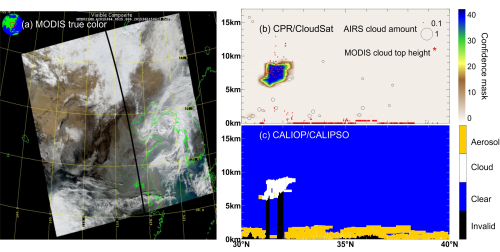
It is very important to observe and study cloud properties because clouds play an important role in weather, climate, and the Earth’s energy balance.
Satellite remote sensing is commonly used to obtain a variety of cloud properties. Haze pollution can reduce human’s vision, but will it also affect the accuracy of satellite cloud detection?
In a paper published in Atmospheric and Oceanic Science Letters, Dr. TAN Saichun, Ms. ZHANG Xiao, Prof. SHI Guangyu, and co-authors from Institute of Atmospheric Physics, Chinese Academy of Sciences, compare cloud detection from four sensors onboard the "A-Train" satellite constellation during two severe haze episodes in winter 2015–2016.
On haze days, the MODIS true-color image (Figure 1a) and CALIPSO (Figure 1c) observed an aerosol layer in eastern China. The AIRS, CloudSat (Figure 1b) and CALIPSO (Figure 1c) did not observe continuous cloud there over the haze region.
However, MODIS observed continuous cloud (Figure 1b), suggesting MODIS misclassified aerosol as cloud. Over the haze region in eastern China, MODIS observed a 13%–49% greater cloud fraction than AIRS.

Figure 1. Haze affects the accuracy of satellite sensor MODIS. (a) MODIS true-color image on haze day. (b) Vertical cross-sections of the CloudSat cloud mask for the orbit shown in (a), with the AIRS and MODIS cloud also shown. (c) CALIPSO cloud and aerosol for the same orbit. (Image by IAP)
"So in severe haze weather, we would suggest that the cloud product of MODIS should be used with caution." says TAN, the lead author of the study.

86-10-68597521 (day)
86-10-68597289 (night)

52 Sanlihe Rd., Xicheng District,
Beijing, China (100864)

